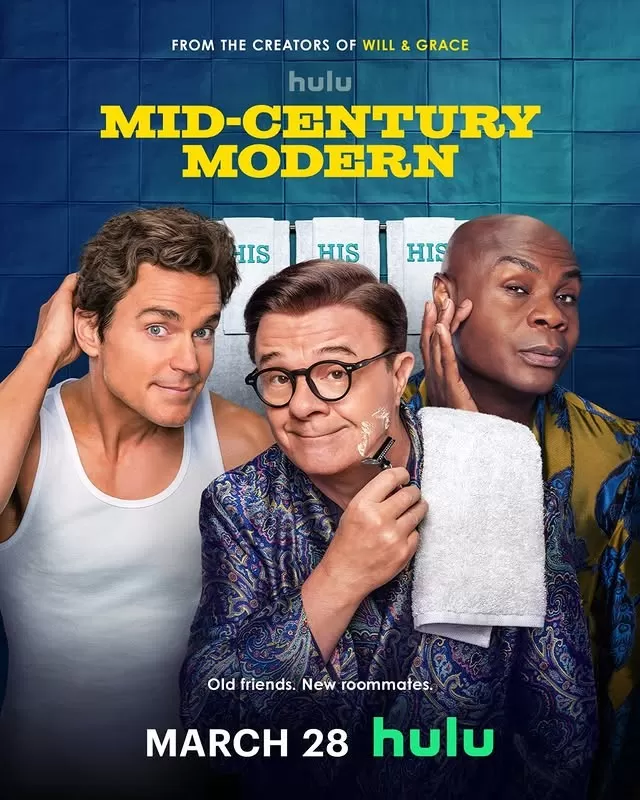
Hulu’s new sitcom, comprising 10 episodes and created by the team behind Will & Grace, naturally piqued my interest. After hearing strong praise, I watched the entire series in a single sitting. Set in Palm Springs, the show centers on three middle-aged gay men who find themselves sharing a home following an unexpected death. As they live together, the trio confronts themes of aging, grief, love, and long-buried secrets. While the series embraces certain LGBTQ+ stereotypes, it does so with humor and a distinctive flair. Nonetheless, despite the hype and positive reviews, I found the show to be only moderately entertaining, eliciting genuine laughter just a few times. Overall, it felt like a typical sitcom experience. Perhaps this response was influenced by my state of mind or expectations, but I did not find it particularly humorous. More reflections on that to follow.
The narrative begins with Bunny, Arthur, and Jerry reuniting at the funeral of a mutual friend—who also happened to be Jerry’s former lover. They gather afterward at Bunny’s expansive Palm Springs mansion, where Bunny lives with his mother, Sybil. Soon, Bunny offers for the two friends to move in. Bunny, the affluent founder of the lingerie brand Bunny Hutch, has filled his stylish Californian home with mid-century modern décor. Despite his wealth, he is lonely and single, caught in a codependent relationship with his mother and hindered by his own insecurities. Arthur, a former Vogue fashion editor, is a sharp-tongued, impeccably dressed individual struggling financially in New York City. Jerry embodies the classic “himbo” archetype—handsome but less intellectually inclined—working as a flight attendant and effortlessly attracting romantic partners. Across the ten episodes, the series explores not only the lives of these three men but also the dynamics involving Bunny’s mother and sister. Bunny is in pursuit of a transformative romance he has yet to experience and wrestles with feelings of unworthiness. Arthur is still reeling from being ousted from the elite fashion scene and often lets his perfectionism manifest excessively. Jerry remains cheerful and attractive, with a background as a former Mormon, relying more on his charm than intellect. Sybil, the overbearing yet well-meaning matriarch, offers constant, if sometimes critical, support.
Each episode offers a vignette into their everyday lives, with the trio navigating love, dating, and unresolved past issues. The narrative underscores that romantic relationships and friendships among gay men have no age boundaries. Over the course of the season, they pursue romantic encounters, host a conservative politician, search for a new housekeeper, and more. True to sitcom form, Mid-Century Modern features evolving characters and recurring themes within a structure of largely self-contained episodes. However, the humor felt dated, reminiscent of 1990s network sitcoms. Many jokes seemed underdeveloped and not as sharp as one might expect today. This may be due to the high expectations I held for the creators, cast, and glowing reviews. The actors performed competently, but I found the characters somewhat underwritten. While I acknowledge my critical stance, I must express disappointment, as the show rarely made me laugh—the primarily intended reaction—despite my hopes for a stress-relieving experience. Some humor verges into raunchiness but remains predictable. The cast fits their roles well, with Sybil, Bunny’s mother, standing out as a scene-stealer. Notably, this was her final acting performance before her untimely passing. Bunny’s sister, Mindy, who returns as a recurring character, fulfills her role as expected.
The show’s title cleverly references both the age of its ensemble cast and the iconic mid-century modern architecture of Palm Springs—an apt designation for a sitcom about gay men of a certain age seeking love, often in comically misguided ways. Their friendship is the central bond that sustains them. Although I had hoped to enjoy the series more profoundly, it ultimately fell short of my expectations. That said, I would still recommend it, as it did bring a smile to my face, even if it rarely inspired a genuine laugh.





